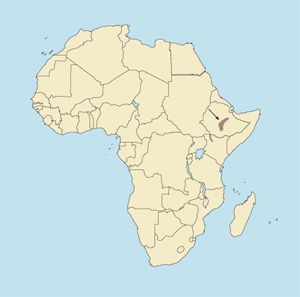 |
Tragelaphus buxtoni
Nyala de montaña (Sp), Bergnyala, Nördlichernyala (G), Nyala de montagne (F). The common name "mountain nyala" is an unfortunate choice, for this animal bears little resemblance to the common nyala of southeastern Africa. At one time called mountain bushbuck, although it appears to be more closely related to the greater kudu. In the Amharic language of Ethiopia its name is yedega-agazen, meaning "highland greater kudu," while that of the greater kudu is yekola-agazen, or "lowland greater kudu." The scientific name is in honor of Ivor Buxton, who took the type specimen in the Sahutu Mountains west of the Arussi Plateau in 1908.
The mountain nyala was the last (in 1908) living ungulate in Africa to be "discovered" by Westerners, and almost the last anywhere.
DESCRIPTION Shoulder height 47-53 inches (120-135 cm). Weight 450-550 pounds (200-250 kg).
A large antelope somewhat resembling a greater kudu, though lacking the shoulder hump, and with much smaller horns. The coat is rather shaggy, the ears are large and the tail is bushy. The lateral hoofs are large and well-developed, probably having evolved as an aid to negotiating steep habitat. Coloration is sandy gray with several pale vertical stripes on the sides. There is a white chevron on the face, two white spots on the cheeks, white patches on throat and base of neck, and several white spots on the hindquarters. The short brown neck mane continues as a brown and white dorsal crest. The horns (males only) are long and heavy with two keels, and form 1-1/2 to 2 open spirals. They grow outward and upward, then pinch inward to form a "bell," with tips that sometimes flare widely and sometimes continue straight up, depending largely upon the region. Females are three-fourths the size of males, hornless, lighter in color, and with a smoother coat.
Specimens from the northern parts of their range (Chercher and Din Din mountains) tend to be somewhat larger and grayer than southern animals. Their horns are longer, and usually have widely flaring tips. Southern specimens (Arussi and Bale mountains) tend to be smaller and browner, with shorter horns and straighter tips.
BEHAVIOR Adult males are usually solitary or in pairs; females and young form small herds. Shy and retiring. Active mainly during evening, night and early morning, seeking thick cover during midday. Mainly a browser, but also eats grasses and herbs. Senses of smell and hearing are very good, eyesight is fair.
HABITAT Dense forest and heather at altitudes of 6,500-13,000 feet (2,000-4,000 m).
DISTRIBUTION Endemic to Ethiopia, it occurs in the Chercher, Din Din, Arussi and Bale mountains, which lie south of the Danakil and east of the Rift Valley. A few can also be found west of the Rift Valley in the vicinity of Ambo, notably on Gibat Mountain.
REMARKS The mountain nyala is one of the very top trophies in Africa, ranking with bongo, giant eland and sitatunga. In the dense forests of the Chercher and Din Din mountains, the usual hunting method is by glassing across forested basins, followed by a very long shot (300-450 yards or 275-410 m, is normal) or by an attempted stalk to closer range. The altitude is about 9,000-10,000 feet (2,700-3,000 m), the terrain is usually steep, with thick cover and poor visibility, and conditions are often cold and wet. Hunting in the high-altitude (12,000-13,000 feet, or 3,600-4,000 m) heather zone of the Arussi and Bale mountains is like mountain hunting anywhere. There is a great deal of glassing, for the heather is frequently higher than a man's head and offers innumerable hiding places. When a shootable bull is spotted, the stalk must be accomplished as quickly as the client-gasping in the thin atmosphere-can manage, for the mountain nyala seldom stays put for long. Two weeks or more must be allotted for this hunt, with success by no means certain.
TAXONOMIC NOTES Although there are noticeable differences between specimens from the northern and southern parts of their range, no subspecies are recognized.
STATUS Listed as endangered by the IUCN.
|





